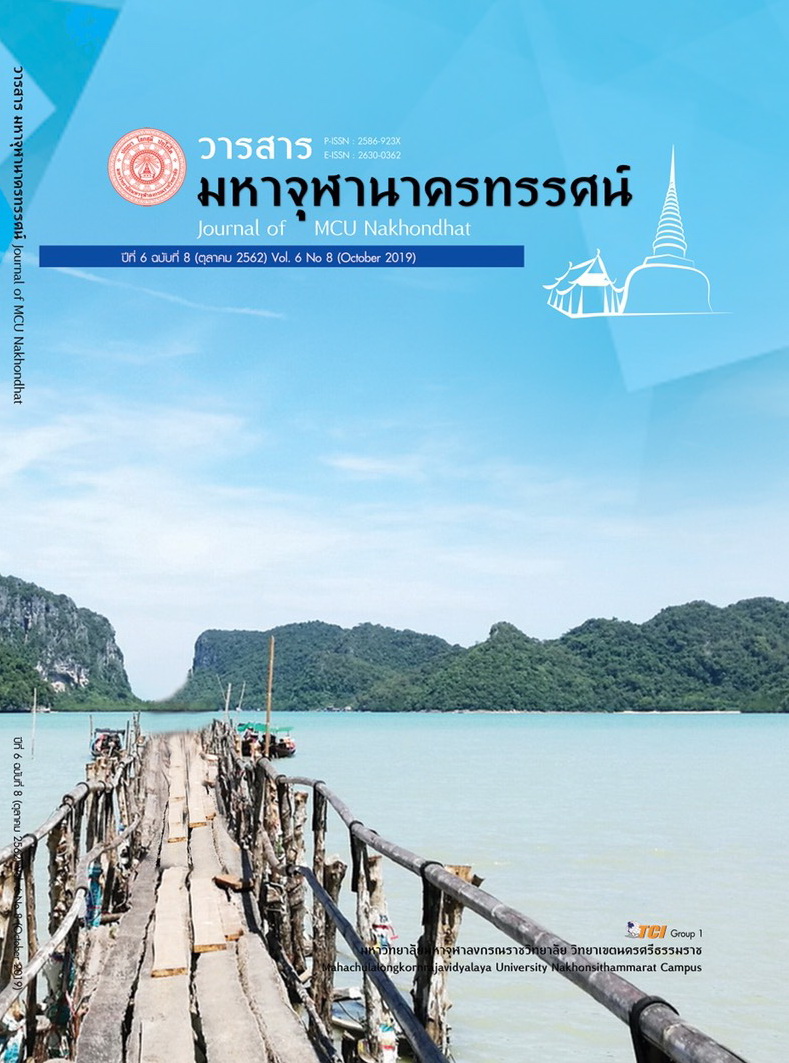STRATEGIC MANAGEMENT BY USING OF GOOD GOVERNANCE PRINCIPLES OF SCHOOLS UNDER THE OFFICE OF SECONDARY EDUCATIONAL SERVICE AREAS, REGION 20
Main Article Content
Abstract
The objectives of this research were: 1) to study the components of administration by good governance’s principles, 2) to study the current situation and desirable conditions of administration by good governance’s principles and 3) to develop strategies for application of good governance’s principles in administration under the Office of Secondary Educational Service Area 20. The sample groups included administrators and teachers under the Office of Secondary Educational Service Area 20with the total number of 342. The research instruments were scale questionnaire with index of Item–Objective Congruence (IOC) value of 0.80-1.00 and reliability at 0.980. The statistics used in data analysis included percentage, mean, standard deviation, PNI modified index.
The research results were found that:
- The components of administration by good governance’s principles in administration under the Office of Secondary Educational Service Area 20 consisted of 7 components namely: 1) Responsibility 2) Transparency 3) The rule of law 4) worthiness 5) Efficiency 6) Participation and 7) Morality.
- The current situation of strategies for application of good governance’s principles in administration under the Office of Secondary Educational Service Area, on a whole, was rated at a moderate level, the desirable conditions of strategies for application of good governance’s principles in administration under the Office of Secondary Educational Service Area, on a whole, were rated at the highest level.
3.The strategies for application of good governance’s principles in administration under the Office of Secondary Educational Service Area comprised 7 strategies as follows: The 1st strategy: Enhancing the rule of law of organization consisted of 4 measures, 3 indicators. The 2nd strategy: Enhancing responsibility consisted of 4 measures, 4 indicators. The 3rd strategy: Increasing performance efficiency consisted of 3 measures, 4 indicators. The 4th strategy: Increasing the work performance worthiness consisted of 3 measures, 4 indicators. The 5th strategy: The development of personnel’s participation consisted of 4 measures, 3 indicators. The 6th strategy: Promoting transparency consisted of 3 measures, 5 indicators. The 7th strategy: Development of sustainable morality system consisted of 5 measures, 7 indicators.
Article Details
References
จิรวรรณ ภักดีบุตร และประกอบ สุทธิกาโมทย์. (2550). เรื่องน่ารู้เกี่ยวกับธรรมาภิบาล. กรุงเทพมหานคร: คณะความมั่นคงแห่งชาติ.
ธีระ รุญเจริญ. (2547). สภาพปัจจุบันและปัญหาการมีส่วนร่วมในการบริหารและจัดการศึกษาของคณะกรรมการการศึกษาขั้นพื้นฐาน. ใน รายงานการวิจัย. สำนักเลขาธิการสภาการศึกษา.
ไพโรจน์ พรหมมีเนตร. (2543). การปฏิบัติงานของคณะกรรมการการศึกษาสังกัดสำนักงานประถมศึกษาจังหวัดพิษณุโลก. กรุงเทพมหานคร: จุฬาลงกรณ์มหาวิทยาลัย.
วิภาส ทองสุทธิ์. (2551). การบริหารจัดการที่ดี. กรุงเทพมหานคร: อินทภาษ.
วีระยุทธ พรพจน์ธนมาศ. (2557). องค์ประกอบของธรรมาภิบาลในโรงเรียน. วารสารนักบริหาร, 34(1), 80-88.
ศราวุธ คำแก้ว. (2559). รูปแบบการมีส่วนร่วมการบริหารจัดการระบบคุณภาพโรงเรียนสู่โรงเรียนมาตรฐานสากล สังกัดสำนักงานเขตพื้นที่การศึกษามัธยมศึกษา. วารสารวิจัยทางการศึกษา คณะศึกษาศาสตร์ มศว, 10(2), 128-141.
สำนักงานคณะกรรมการการพัฒนาเศรษฐกิจและสังคมแห่งชาติ. (2559). แผนพัฒนาเศรษฐกิจและสังคมแห่งชาติฉบับที่ 12 (พ.ศ.2560 – พ.ศ.2564). กรุงเทพมหานคร: สำนักนายกรัฐมนตรี.
สำนักงานคณะกรรมการการศึกษาขั้นพื้นฐาน. (2551). แนวการดำเนินงานการมีส่วนร่วมการนบริหารการจัดการศึกษา. กรุงเทพมหานคร: โรงพิมพ์ชุมนุมการเกษตรแห่งประเทศไทยจำกัด.
สุดจิต นิมิตกุล. (2543). “กระทรวงมหาดไทยกับการบริหารจัดการที่ดี”การปกครองที่ดี (Good Governanc) . กรุงเทพมหานคร: บพิธการพิมพ์.
อริย์ธัช แก้วเกาะสะบ้า. (2548). ธรรมาภิบาลกับหลักสิทธิเสรีในรัฐธรรมนูญ. กรุงเทพมหานคร: พิมพ์ลักษณ์.


